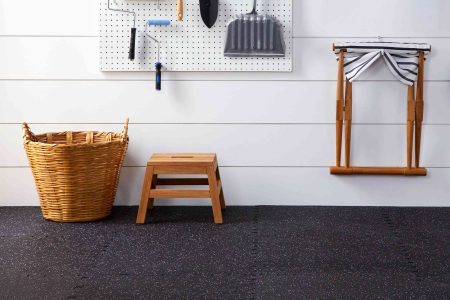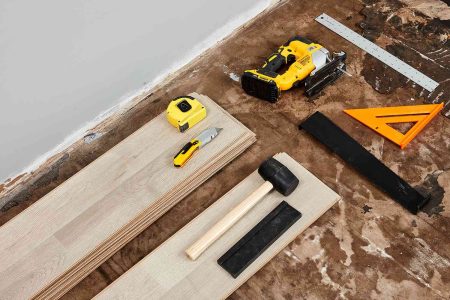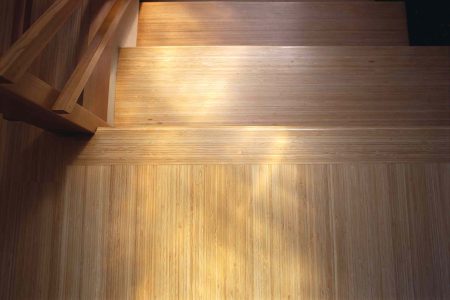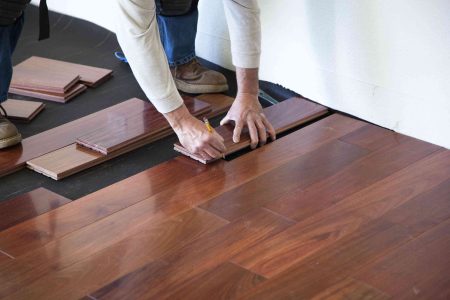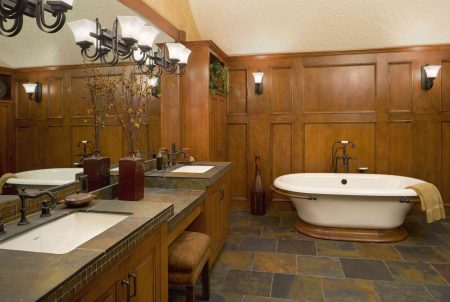Brick is one of the oldest and most common building materials in the world, first developed as a substitute for natural stone. Traditionally, brick is made from earthen clays, shaped into rectangular blocks, then dried or fired to harden them for constructing walls or paving surfaces. The bricks used for flooring are known as clay pavers, and the type used for indoor applications are comprised of several different clays, including kaolin (China clay) that gives it a finer, denser texture that makes for a more attractive floor. Brick flooring pavers also include shale and iron in the composition to make them harder.
Clay brick pavers are typically shaped the same as wall brick, but they are thinner, anywhere from 1/4 inch to about an inch thick. They are best suited for installation over concrete slabs on ground floors, since the weight is too great for a wood-framed flooring system to support. Brick flooring is very durable, but it requires sealing to protect it from stains, and its rustic appearance is not a good fit for every home design. And brick flooring is very hard, which makes it a poor choice if coziness is the goal.
-
Durable and easy to clean
-
Non-allergenic
-
Fireproof
-
Adds drama
-
Non-slip surface
-
Hard surface
-
Susceptible to stains
-
Requires sealing
Brick Flooring Cost
Brick pavers range in cost from about $3 to $10 per square foot, depending on the specific type of material. This does not include installation, which can add another $5 to $10 per square foot. This makes brick flooring less expensive than natural stone and many ceramic tile installations.
Maintenance and Repair
The main advantages of brick flooring are similar to those of ceramic and stone tile. Brick is a highly durable material that is not easily damaged by the rigors of a busy household, pets, high-traffic, or frequently moved furniture. Brick’s hard surface makes it easy to clean—with a quick sweep or vacuuming
Because brick is made of clay and is grouted with cementitious mortar, brick floors are highly susceptible to stains unless they are properly sealed. In most cases, a sealer should be applied soon after the flooring is installed, and it needs to be reapplied periodically throughout the life of the floor to maintain protection.
There are two general types of sealers for brick floors. Penetrating sealers soak into the brick, leaving most of the surface texture and original coloring intact. Film-forming sealers (such as acrylic or polyurethane) create a coating over the top of the brick, resulting in a slicker, shinier surface that darkens the brick’s color.
Design
Aesthetically, brick flooring fits best with rustic home styles, such as cottage- or farm-style residences, and in rooms where an informal look is desired, such as sun porches or entryways. Because brick is noncombustible, it’s a good choice for flooring under or near wood stoves and fireplaces, where brick is traditionally right at home.
As a bold design element, brick is hard to beat. It adds visual warmth, texture, color and eye-catching pattern all at once.
Brick Flooring Installation
Like other forms of tile, brick pavers are adhered to a subfloor (usually a concrete slab) using thin-set adhesive. Brick flooring is very heavy, but it can also be installed on wood subfloors if you make sure the flooring system framing is sturdy enough to hold the weight. Determining this may require that you consult a building engineer. In this type of installation, a layer of cement-board is put down as underlayment over the wood subfloor, then the brick pavers are applied over the cement board with thin-set adhesive.
Once the adhesive is fully dried, the spaces between the bricks are grouted in the same manner used for natural stone or ceramic tiles. Some flooring bricks come in sheets, much like mosaic tiles, that are installed with mortar and can be fitted together in different configurations to create custom patterns.
Brick flooring is not particularly difficult for DIYers to install, as the techniques are virtually identical to those used to install other forms of tile. Cutting brick, however, does require a power wet saw equipped with a diamond blade, which is available for lease at tool rental centers.
Top Brands of Brick Flooring
There are a few brands that sell interior brick floor tiles, but many clay brick pavers are also manufactured at regional brickyards. Discuss your project with a local brickyard or masonry supply retailer, and make sure to specify that you are looking for an indoor paving brick.
Comfort and Convenience
The durability of brick has a flip side: hardness. It’s no more comfortable underfoot than tile, stone, or concrete. And as with these other hard materials, brick can be cold on bare feet in winter, although it makes a good surface above in-floor radiant heat. Hardness also means you have to worry about dropped objects shattering on impact.
Brick Flooring vs. Terra Cotta Tile
Another clay-based product commonly used for flooring is terra cotta tile. Terra cotta tiles are typically larger tiles, made from a finer potter’s clay that is different in texture than the coarser clays used for brick pavers. The clay used in terra cotta has a high iron content that gives the material a reddish color. Terra cotta can be glazed or unglazed; when unglazed tiles are used, it must be sealed in much the same way as brick pavers.
Terra cotta has a smoother texture than brick pavers, and since the tiles are much larger, there are fewer joints to grout and maintain. Terra cotta also produces a more elegant appearance than brick, and it is more suitable for use throughout the house. Terra cotta also weighs less, and it can be used in situations where brick pavers are too heavy for the floor to support.
Is Brick Flooring Right for You?
Brick flooring can be a good choice where you want a long-lasting flooring that lends a dramatic, rustic appearance. It is ideal for informal rooms, such as sunrooms, mudrooms, or laundry areas. Brick flooring is best installed over a concrete slab or structurally reinforced wood subfloor. Be prepared to seal the floor after installation, and renew the seal coat every few years.
Read the full article here




